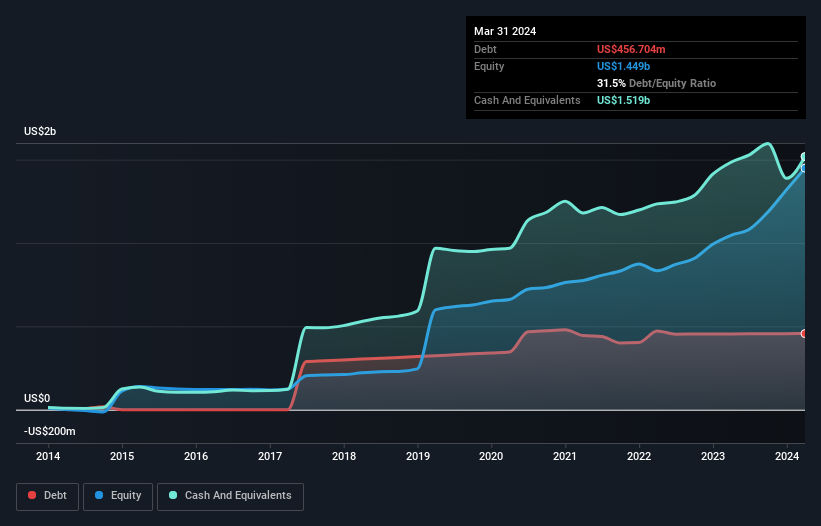
Legendary fund manager Li Lu (who Charlie Munger backed) once said, 'The biggest investment risk is not the volatility of prices, but whether you will suffer a permanent loss of capital.' When we think about how risky a company is, we always like to look at its use of debt, since debt overload can lead to ruin. We note that HubSpot, Inc. (NYSE:HUBS) does have debt on its balance sheet. But is this debt a concern to shareholders?
What Risk Does Debt Bring?
Debt assists a business until the business has trouble paying it off, either with new capital or with free cash flow. Ultimately, if the company can't fulfill its legal obligations to repay debt, shareholders could walk away with nothing. However, a more common (but still painful) scenario is that it has to raise new equity capital at a low price, thus permanently diluting shareholders. Of course, debt can be an important tool in businesses, particularly capital heavy businesses. When we think about a company's use of debt, we first look at cash and debt together.
View our latest analysis for HubSpot
How Much Debt Does HubSpot Carry?
The chart below, which you can click on for greater detail, shows that HubSpot had US$456.7m in debt in March 2024; about the same as the year before. But it also has US$1.52b in cash to offset that, meaning it has US$1.06b net cash.

A Look At HubSpot's Liabilities
We can see from the most recent balance sheet that HubSpot had liabilities of US$959.6m falling due within a year, and liabilities of US$784.4m due beyond that. Offsetting this, it had US$1.52b in cash and US$266.9m in receivables that were due within 12 months. So it can boast US$41.5m more liquid assets than total liabilities.
Having regard to HubSpot's size, it seems that its liquid assets are well balanced with its total liabilities. So it's very unlikely that the US$29.2b company is short on cash, but still worth keeping an eye on the balance sheet. Simply put, the fact that HubSpot has more cash than debt is arguably a good indication that it can manage its debt safely. When analysing debt levels, the balance sheet is the obvious place to start. But it is future earnings, more than anything, that will determine HubSpot's ability to maintain a healthy balance sheet going forward. So if you want to see what the professionals think, you might find this free report on analyst profit forecasts to be interesting.
Over 12 months, HubSpot reported revenue of US$2.3b, which is a gain of 24%, although it did not report any earnings before interest and tax. With any luck the company will be able to grow its way to profitability.
So How Risky Is HubSpot?
Although HubSpot had an earnings before interest and tax (EBIT) loss over the last twelve months, it generated positive free cash flow of US$288m. So taking that on face value, and considering the net cash situation, we don't think that the stock is too risky in the near term. We think its revenue growth of 24% is a good sign. We'd see further strong growth as an optimistic indication. When analysing debt levels, the balance sheet is the obvious place to start. But ultimately, every company can contain risks that exist outside of the balance sheet. Case in point: We've spotted 2 warning signs for HubSpot you should be aware of.
If you're interested in investing in businesses that can grow profits without the burden of debt, then check out this free list of growing businesses that have net cash on the balance sheet.
Valuation is complex, but we're here to simplify it.
Discover if HubSpot might be undervalued or overvalued with our detailed analysis, featuring fair value estimates, potential risks, dividends, insider trades, and its financial condition.
Access Free AnalysisHave feedback on this article? Concerned about the content? Get in touch with us directly. Alternatively, email editorial-team (at) simplywallst.com.
This article by Simply Wall St is general in nature. We provide commentary based on historical data and analyst forecasts only using an unbiased methodology and our articles are not intended to be financial advice. It does not constitute a recommendation to buy or sell any stock, and does not take account of your objectives, or your financial situation. We aim to bring you long-term focused analysis driven by fundamental data. Note that our analysis may not factor in the latest price-sensitive company announcements or qualitative material. Simply Wall St has no position in any stocks mentioned.
Have feedback on this article? Concerned about the content? Get in touch with us directly. Alternatively, email editorial-team@simplywallst.com
About NYSE:HUBS
HubSpot
Provides a cloud-based customer relationship management (CRM) platform for businesses in the Americas, Europe, and the Asia Pacific.
Flawless balance sheet with high growth potential.
Similar Companies
Market Insights
Community Narratives



